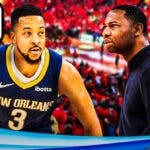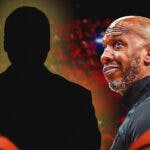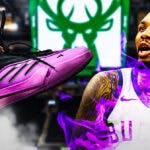The Portland Trail Blazers squandered a seven-point halftime lead on Sunday, falling to the Charlotte Hornets 125-113 on the first leg of a tough Eastern Conference back-to-back. Here are three takeaways from the Blazers' Halloween loss to Charlotte, one highlighted by another sinister shooting night from Damian Lillard.
Porous Second-Half Defense
Portland got control of this game right before halftime, closing the second quarter on an 11-4 run with stellar passing and active defense. Charlotte wasn't exactly struggling to find makable looks and went into intermission with 17 assists, but the Blazers' energy and engagement on defense at least made offense difficult to come by for the home team at times.
Instead of making some subtle adjustments that could better keep Charlotte in check, though, Portland was absolutely ripped to shreds on defense in the second half. The Hornets drained 10 threes, shot 66.6 percent on twos and doled out 19 assists after halftime, racking up a 141.2 offensive rating—the type of sky-high number normally reserved for video games.
The Blazers' effort, though it occasionally waned, wasn't their issue defensively. Billups clarified what seemed obvious while watching the game: Portland, after making tweaks to their defensive coverage at halftime and in real-time, just wasn't on the same page.
“A lot of broken coverages. We changed up the coverages a few times,” he said. “Two or three guys doing it the right way, and the other two or three guys kinda not making the adjustment, doing the coverage that we changed it from, and that cost us several times. A lot of over-helps cost us several times. Probably just wasn't focused enough defensively in the second half.”
Ish Smith is six feet tall and came into Sunday's game shooting 37.1 percent on drives, per NBA.com/stats. More importantly, C.J. McCollum and Jusuf Nurkic have both Smith's drive and a potential drop-off to Mason Plumlee handled. What is Robert Covington doing cheating off the weak wing to below the dotted line, leaving a hot shooter wide open when the Blazers could really use a fourth-quarter stop?
As much as he's over-helped in similar situations in the season's early going, picking on Covington alone isn't fair.
Portland made life way too easy on Charlotte ball-handlers at the point of attack, and wasn't as fast or physical on the backline as it was in Friday's blowout win over the LA Clippers. The Blazers' massive size disadvantage on the perimeter and wing played a factor in their defensive struggles, too. The 2-3 hybrid zone looked ugly.
The Hornets were an awesome offense even before they got Terry Rozier back from a sprained ankle on Sunday. Few teams in the league should walk into Spectrum Center and expect a victory. But given how solid Portland looked at times in the first half despite poor shooting from its stars, the ultimate tenor of this loss is definitely disappointing.
Bright Spots From The Bench
Single-game plus-minus is more meaningless than meaningful, but it's still difficult to ignore when it aligns so closely with the eye test. Lillard's plus-six was best among the Blazers' opening five; every other starter was in the red at minus-12 or worse. Those numbers seem especially relevant considering the life Portland's reserves consistently brought to the game when Billups called them off the bench.
Anfernee Simons came in on a heater, hitting a catch-and-shoot triple on his very first touch. He was Portland's only volume shooter who had it going from deep on Sunday, going 5-of-8 on threes en route to a season-high 19 points. Nassir Little had some strong moments as an individual defender and knocked down two of his three triples, also continuing to make an impact on the glass. Larry Nance Jr. looked as comfortable as he has all season offensively and helped stanch some bleeding on the other end late in the third quarter. In his return to the only team he'd known before the Blazers, Cody Zeller did pretty much everything that so endeared him to Charlotte for the better part of a decade.
The blend of nuance, pace and skill Nance exhibits here is exactly why among the many reasons Portland traded for him.
Maybe the biggest one, though? The small-ball opportunities Nance's positional and stylistic versatility unlocks.
Billups ultimately went to that look as the Hornets pulled away, but before it was too late. The Blazers' had Nance and Little up front next to their three starting guards during the last competitive portion of the game, switching across five positions and playing with five shooters on the other end. They trailed by nine with 4:12 left when Billups went to that unit, never getting closer than six.
Why Portland didn't roll it out earlier only Billups knows for sure, especially in light of Zeller subbing Nurkic out for good two-and-a-half minutes earlier. Next time, hopefully.
Shooting Blanks
Lamar Hurd highlighted on the television broadcast that Lillard was back on the floor early after heading to the halftime locker room, getting some additional shots up in advance of the third quarter. Was that a sign of Lillard's mounting frustration as his shooting struggles continued? Perhaps. It didn't yield the changes he wanted either way, Lillard going 1-of-9 from deep in the second half before making another when the game was essentially over.
The difference between Sunday's game and others this season is that McCollum wasn't much better than his backcourt mate against the Hornets. He needed 24 shots to score 25 points, his fourth triple on his 11th attempt coming just prior to Billups waving the white flag by going deep into his bench.
Lillard and McCollum combined for 39 points against Charlotte, shooting 15-of-44 from the field and taking just four free throws. Widespread defensive issues aside, Billups told it best about a game the Blazers had a puncher's chance to win when their stars shot so poorly.
“Look, we come into a game like this and between Dame and CJ they go 6-25 from three, it's gonna be tough to win a game like that,” he said. “I just feel like this was a winnable game even with those two dudes struggling from three. To me that's a good sign.”
Lillard didn't speak with reporters after the game. He again missed many makable jumpers on his way to 5-of-20 shooting, but also failed to get the separation he normally does on a handful of attempts in isolation and pick-and-roll. When was the last time Lillard got his shot blocked like this?
That's an insanely difficult step-back and Cody Martin is a very good individual defender. Lillard played another solid floor game when he wasn't forcing the issue offensively, finishing with 12 assists against just two turnovers. It's also no harsh criticism to admit that Lillard was clearly bothered at times by Charlotte's length on the ball.
Bottom line: The slump isn't over. Lillard, remember, didn't suggest otherwise even after beginning to break out of it against the Clippers. But there were some moments in Sunday's game that Lillard's labors seemed like they could be more than simply the make-or-miss nature of jump-shooting. Until the inevitable explosion comes—maybe on Monday against the Philadelphia 76ers—they're at least worth monitoring.




